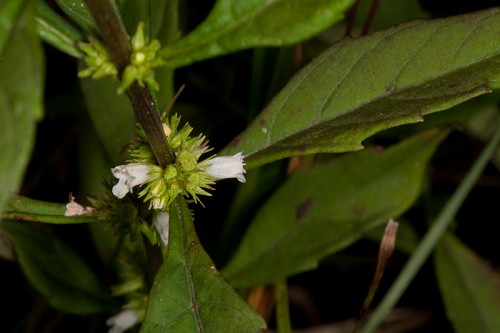Lycopus rubellus
| Lycopus rubellus | |
|---|---|

| |
| Photo by the Southeastern Flora Database | |
| Scientific classification | |
| Kingdom: | Plantae |
| Division: | Magnoliophyta - Flowering plants |
| Class: | Magnoliopsida - Dicots |
| Order: | Lamiales |
| Family: | Lamiaceae |
| Genus: | Lycopus |
| Species: | L. rubellus |
| Binomial name | |
| Lycopus rubellus Moench | |

| |
| Natural range of Lycopus rubellus from USDA NRCS Plants Database. | |
Common Names: stalked bugleweed;[1] taperleaf water horehound[2]
Contents
Taxonomic Notes
Synonyms: L. velutinus Rydberg; L. angustifolius.[3]
Varieties: none.[3]
Description
Lycopus rubellus is a dioecious perennial forb/herb.[2] It produces white flowers.[4] Leaves are lance-ovate and 5-12 cm long with a sessile or short petiole. Rhizomes produce tubers at the extremities.[5]
Distribution
This species occurs from Maine, westward to Michigan, and southward to Florida and Texas.[1] Reports also exist for its occurrence in Oregon.[2]
Ecology
Habitat
L. rubellus has been found in mesic woodlands, lake shores, cypress-gum swamps, longleaf pine forests, titi-oak forests, pine flatwoods, marsh edges, sandbars, and stream banks.[6] It is also found in disturbed areas including roadsides, along railroads, and burned pine bog-flatwoods.[6] Associated species: Cyperus erythrorhizos, Juncus canadensis, Eleocharis robbinsii, Fuirena pumila, Habeneria repens, Triadenum virginicum and spp. of Ludwigia, Panicum, Rhynchospora, Decodon verticillatus, Commelina virginica, Mecardonia and Panicum gymnocarpon, Leersia and Hygrophila, and Xyris fimbriata.[6]
On Arkansas floating mats, L. rubellus composed less than 1% of the vegetative cover.[7] In Indiana, L. rubellus grows on floating logs, stumps, and at bases of living trees. It is also a characteristic species of sinkhole wetlands.[8]
Phenology
In the southeastern and mid-Atlantic United States, L. rubellus flowers from June through November.[1] For L. rubellus in Mississippi, flowering occurs from September through October.[9]
Seed bank and germination
After submerging seeds in a water filled jar for 130 days, speeds from L. rubellus still germinated and produced seedlings.[10] However, in South Carolina, L. rubellus is only found above or at the waterline.[11]
Pollination
The polar axis of L. rubellus pollen grains have been reported as 23.75-30.00 µm[12] and 12.0-16.8 µm.[13] This large difference between studies could be caused by geographic variation or differences in chromosome number.[12]
Conservation, cultivation, and restoration
Cultural use
Photo Gallery
References and notes
- ↑ 1.0 1.1 1.2 Weakley AS (2015) Flora of the Southern and Mid-Atlantic States. Chapel Hill, NC: University of North Carolina Herbarium.
- ↑ 2.0 2.1 2.2 USDA NRCS (2016) The PLANTS Database (http://plants.usda.gov, 01 February 2018). National Plant Data Team, Greensboro, NC 27401-4901 USA.
- ↑ 3.0 3.1 Weakley, A.S. 2015. Flora of the southern and mid-atlantic states. Working Draft of 21 May 2015. University of North Carolina at Chapel Hill, Chapel Hill, North Carolina.
- ↑ Plant database: Lycopus rubellus. (01 February 2018) Lady Bird Johnson Wildflower Center. URL: https://www.wildflower.org/plants/result.php?id_plant=LYRU
- ↑ Tobe JD, Burks KC, Cantrell RW, Garland MA, Sweeley ME, Hall DW, Wallace P, Anglin G, Nelson G, Cooper JR, Bickner D, Gillbert K, Aymond N, Greenwood K, Raymond (1998) Florida Wetland Plants: An Identification Manual. Florida Department of Environmental Protection, Tallhassee, FL.
- ↑ 6.0 6.1 6.2 Florida State University Herbarium Database. URL: http://herbarium.bio.fsu.edu. Last accessed: June 2021. Collectors: Loran C. Anderson, Kathleen Craddock Burks, E.S. Ford, James P. Gillespie, Robert K. Godfrey, R. Kral, B. Moore, John Morrill, and D.B. Ward. States and counties: Florida: Franklin, Gulf, Jackson, Jefferson, Leon, Levy, Liberty, Taylor, Washington, and Wakulla. Georgia: Thomas.
- ↑ Huffman RT, Lonard RI (1983) Successional patterns on floating vegetation mats in a southwestern Arkansas bald cypress swamp. Castanea 48(2):73-78.
- ↑ Homoya MA, Hedge CL (1982) The upland sinkhole swamps and ponds of Harrison County, Indiana. Proceedings of the Indiana Academy of Science 92:383-388.
- ↑ Jones SB Jr. (1976) Mississippi flora V. the mint family. Castanea 41(1):41-58.
- ↑ Shull GH (1914) The longevity of submerged seeds. The Plant World 17(11):329-337.
- ↑ Collins B, Wein G (1995) Seed bank and vegetation of a constructed reservoir. Wetlands 15(4):374-385.
- ↑ 12.0 12.1 Moon H, Hong S (2003) Pollen morphology of the genus Lycopus (Lamiaceae). Annales Botanici Fennici 40:191-198.
- ↑ Trudel MCG, Morton JK (1992) Pollen morphology and taxonomy in North American Labiatae. Canadian Journal of Botany 70(5):975-995.